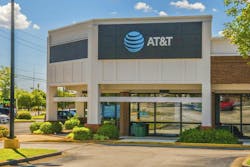AT&T is hot on the trail of enhancing its fiber broadband network reach. The telco maintains that it’s on track to pass over 30 million locations with fiber by the end of 2025.
John Stankey, CEO of AT&T, told investors during its fourth-quarter earnings call that its aggressive build-out strategy sets it apart from the competition.
“We'll continue to extend our lead as the company that reaches more homes and businesses with fiber,” he said. “We remain on track to pass our 30 million-plus consumer and business fiber location target by the end of 2025.”
However, the telco maintains that it could extend its reach beyond its initial target.
Stankey reiterated comments during the UBS Global TMT Conference that if the conditions are right, AT&T could bring fiber to several million more locations.
“As I mentioned last month, the better-than-expected returns we are seeing on our fiber investments potentially expand the opportunity to go beyond our initial target by roughly 10 million to 15 million additional locations,” he said. “This also assumes similar build parameters in a regulatory environment that remains attractive to building infrastructure.”
Scaling fiber
AT&T Fiber’s network continues to scale.
Since 2020, AT&T has scaled the number of locations it passes with fiber from 18 million to over 26 million consumer and business locations.
As AT&T expands the reach of its fiber network, its fiber customer base is growing. Having gained 1.1 million AT&T Fiber net adds in 2023, Stankey said AT&T generated over 1 million AT&T Fiber net adds annually for six straight years.
“Over the past three years, we've grown AT&T Fiber subscribers by 3.4 million or nearly 70% to more than 8.3 million,” he said. “This success reflects new customer wins and lower churn, trends we see as sustainable.”
Overcoming seasonality, slower home movement
Fiber growth continued into the fourth quarter.
This period was notable because AT&T overcame seasonality and slower household moves, adding 273,000 fiber customers. This marks 16 straight quarters with more than 200,000 net adds and the sixth consecutive year with 1 million or more AT&T Fiber net adds.
Total broadband gains, excluding DSL, were 19,000, reflecting AT&T Fiber net adds of 273,000 and AT&T Internet Air net adds of 67,000, more than offsetting other non-fiber losses. “The financial and operational performance of our fiber business exceeds our initial expectations,” said Pascal Desroches, CFO of AT&T. “Wherever we have fiber, we continue to win.”
Fiber broadband gains drove consumer revenues up 3.8% yearly to $3.4 billion, offsetting declines in legacy voice and data and other services. Broadband revenues increased 8.3% due to fiber growth of 21.9%, partly offset by non-fiber revenue declines of 8.4%. Fiber ARPU was up $0.29 sequentially, with intake ARPU now at more than $70.
“Consumer Wireline EBITDA grew more than 10% for the quarter and more than 8% for the full year due to growth in fiber revenues and the more efficient cost profile of fiber,” Desroches said.
He added that AT&T is also progressing with its broadband wireless offering, AT&T Internet Air. “While fiber remains our focus and lead product, we've also been encouraged by the initial introduction of AT&T Internet Air, our targeted fixed wireless access service,” Desroches said. “We had 93,000 AT&T Internet air subscribers at the end of the year and now offer this service in parts of 35 locations.”
Other fiber benefits
AT&T’s fiber deployment is providing the company with various benefits.
On the financial side, AT&T has doubled its fiber revenues to over $6.2 billion in 2023. The telco also increased broadband ARPU by 20% to $68.50 as customers seek higher-value plans with faster speeds.
Desroches attributes the ARPU and revenue increase to “customers continue to seek higher-value plans with faster speeds.”
However, Telco is also finding that fiber enhances its operational construct. Unlike copper-based wiring, fiber is a more resilient medium supporting up to 10 Gbps speeds. It also has future-proofing capabilities as network speeds and requirements increase.
“In addition to delivering high-margin revenue growth, fiber is more energy efficient, requires less maintenance and customers keep the service longer,” Desroches said. “Therefore, as we scale our fiber footprint, we expect to continue to drive margin expansion. This flywheel of faster subscriber growth, higher revenues and expanding margins gives us confidence in our ability to repeat similar levels of fiber-fueled growth in the future.”
For more news, products, and technical profiles in broadband cable and telecommunications technology, subscribe to BTR's newsletter and follow us on LinkedIn, Twitter, and Facebook.
